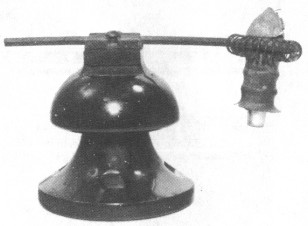Porcelain Insulator News
by Elton Gish, NIA #41
Reprinted from "Crown Jewels of the Wire", January 1988, page 24
In the February 1987 Crown Jewels on page 31, we asked for readers to give us
a clue as to the use of the "what-is-it" illustrated there. This
question has been asked many times over the past years with no one stepping
forward with the answer -- until now.
Marion Oschman (NIA #734) has supplied us with the answer and even sent me
one to photograph and examine first hand. His letter explains the purpose very
well:
Dear Elton,
In reference to Tim Robinson's "what-is-it on page 31 of the February
Crown Jewels, this has been questioned before and I assumed that someone else
would write in with an explanation. You may receive a deluge of answers this time.

This is a stand off insulator used on the inside of the more modern neon
signs. It was used in the same way as Gerald Brown's
"spook" (see Brown's 3rd
revision of Collectible Porcelain Insulators). The clamp on top secures a
square copper wire thru a transformer to ignite the neon gas in the tubes of the
sign. I have found them with black and brown glazes, but no embossing, so have
no info as to the manufacturer. Tim Robinson is right about the indentations in
the hose. These accommodate a metal clip that secured the insulator to the inner
wall of the sign. I have 10 or 15 different types of neon insulators in both glass
and porcelain.
I am sending you one with the end wire attached. You can see the broken end
of the glass tube inside the metal piece.
Marion
- - - - - - - - - -
Thanks Marion for taking this insulator off of the "what-is-it"
list. I want to thank Pauline Ingersoll who also sent one of these unusual
insulators for my closer examination.
Dear Elton,
I have an unusual insulator that doesn't match any U-Chart styles in Jack Tod's
book Porcelain Insulators Guide Book for Collectors. It is similar to
U-514 in general shape and is 5-1/8" tall and 3-3/4" wide at the skirt
(see the two photos at top of next page). It is a real giant compared to a U-5l4
and has a much longer skirt. The most unique thing is the sanded pinhole. The
pinhole does not have threads but instead has the sanded coating much like
pieces which are cemented to metal pins. The pinhole tapers radically and is
glazed under the sand.
The crown side is incused marked THOMAS and it has a dark chocolate brown
glaze color.
What do you make of this? I have seen many suspension types with this sand coating,
but never anything like a pin-type. Can you cast any light on this?
Mike Guthrie (NIA #3297)
- - - - - - - - - -
Dear Mike,
Your Sim U-506 with the very long petticoat and stretched vertically overall 5-1/8"
tall], sanded hole for metal equipment pin -- incuse marked Thomas is a
mouthful description that will have to do as this sanded hole style was only
available as an "equipment insulator" and does not qualify for inclusion
in the U-Chart.
Sanded holes are not unusual in pin types when it is a case of the use of
metal thimbles which are naturally cemented into the sanded hole. For this to be
the case, it means styles normally used that way, on metal pins, either for
radio frequency interference (RFI) solutions or for high mechanical stress --
namely the larger HV insulators. Many of the large uniparts in the U-Chart were
cataloged as metal-thimble, but were drawn with porcelain threads for simplicity
and especially if that option was also available in the catalog listing.
Yours was made specifically for use with a cemented-in pin -- or for use in
cementing onto a pin at some fixed installation. As such, these are referred to
as "equipment insulators". They naturally could take any shape, but the ones
that attract our attention are ones like yours which outwardly are a pin type
shape. Some would have mating surfaces for other equipment bases, embedded attachment studs
metal caps or whatever.
These items which were only available as "equipment insulators"
have always been excluded from the U-Chart which was meant only for pin types
one could see on a crossarm. As you might guess, all of these (except one) would
only be found with cemented pins or at fixed equipment locations. These units would
not be easily available to collectors. Yours must have been on a supply shelf for 40 years
left over from some project.
Elton
Dear Elton,
The other day, I picked up a U-244A Macomb insulatar in Tucson for $5. It is
chocolate in color and is mint except for a very small inner skirt chip. Are
these very common?
Matt Poage
- - - - - - - - - - -

Dear Matt,
The U-244A Macomb is a very good find indeed at that price. It is not known
how many are in collections. In CJ 1-83-32 issue, Robert Chiantelli (Monterey, CA)
found "quite a few" of these but most never found their way into
collector's hands. It is anyone's guess as to numbers (guess 10 to 30), but this
item is next to impossible to acquire. The U-244B is rarer with only about four
known. The second rarest Macomb is U-197A then U-599B with only one known.
Macomb collectors are probably still looking for a U-244A. You should receive
calls about it after this comes out from those wanting to add this piece to
their collection. You will undoubtedly get a nice trade piece in return. Just
goes to show that good porcelain bargains are still available if you are in the
right place at the right time rather than wandering around at the wrong places
as is my usual luck.
Elton
| 